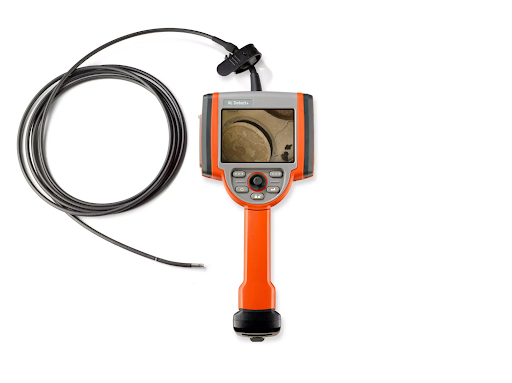Table of Content
- Video Borescope Care Basics
- Borescope Maintenance Tips
- Borescope Usage Best Practices
- Troubleshooting Common Issues
- Advanced Care Techniques
- Safety Measures
- Training and Skill Development
- Conclusion
Video Borescope maintenance is key to keeping it working well for a long time. A properly maintained borescope gives you clear inspections and trustworthy results. This is vital for any professional using this tool.
A video borescope has an insertion tube, a lens, a monitor, and a control unit. It captures images in hard-to-reach places with a camera. The borescope inspection checklist helps maintain flexibility and accuracy, making it a must-have in many industries.
Video Borescope Care Basics
Video Borescope care basics include keeping the insertion tube clean and free of debris. Proper care and maintenance will ensure that your video borescope continues to provide reliable performance for years to come.
1. Daily Care Routine
To keep your borescope in top condition, develop a daily care routine. This includes checking for any visible damage, ensuring the lens is clean, and verifying that all connections are secure.
2. Weekly Care Checklist
Once a week, perform a more thorough inspection. Check the insertion tube for any signs of wear, clean the monitor screen, and update the software if necessary. This regular maintenance will help prevent minor issues from becoming major problems.
3. Cleaning Techniques
Clean the lens, insertion tube, and monitor with a soft cloth and a mild cleaning solution. Avoid using abrasive materials to avoid scratching the surface. Keep the monitor clean for clear visibility with a screen-safe solution and a microfiber cloth.
Borescope Maintenance Tips
1. Handling the Borescope with Care
Always handle your borescope gently. Avoid bending the insertion tube sharply, and never force the device into tight spaces. Proper handling reduces the risk of damage and prolongs the borescope’s life.
2. Regular Software Updates
Keeping your borescope’s software up-to-date is essential for optimal performance. Regular updates can fix bugs, improve functionality, and ensure compatibility with other devices and software.
Borescope Usage Best Practices
Borescope usage best practices involve storing it in a protective case and avoiding bending or kinking the insertion tube to prevent damage.
1. Optimal Operating Conditions
Use your borescope in the conditions that it is rated for. Avoid using it in environments that are too hot, too cold, or excessively dusty, as these can affect its performance and longevity.
2. Avoiding Common Mistakes
Common mistakes include forcing the insertion tube into tight spaces and neglecting regular maintenance. Always follow the manufacturer’s guidelines to prevent these issues.
Mentor Visual iQ+ HD VideoProbe, Mentor Visual iQ HD VideoProbe, XL Detect, and XL Detect+ VideoProbes enhances remote visual inspections with artificial intelligence, cloud-based tools, and TrueSightTM imaging for improved detection.
Best Practices for Engine Inspections with Borescope
Troubleshooting Common Issues
If you experience issues with image quality, try cleaning the lens and ensuring proper lighting.
1. Image Quality Problems
If you experience image quality issues, first clean the lens and check the monitor settings. If problems persist, consult the user manual or contact customer support.
2. Software Glitches
For software-related issues, try rebooting the device or performing a factory reset. Ensure your software is up-to-date to minimise glitches.
3. Physical Damage
Inspect your borescope regularly for any physical damage. If you notice any cracks or breaks, stop using the device immediately and get it repaired.
Advanced Care Techniques
To prolong the lifespan of your borescope, follow Advanced Video Borescope maintenance techniques to avoid exposing it to extreme temperatures or harsh chemicals. Additionally, store it in a protective case when not in use to prevent any damage.
1. Calibrating Your Borescope
Calibration ensures that your borescope provides accurate measurements and images. Follow the manufacturer’s instructions for calibration, or seek professional help if needed.
2. Using Specialized Cleaning Solutions
In some cases, you might need specialised cleaning solutions for your borescope. Always use products recommended by the manufacturer to avoid damaging the device.
Safety Measures

Always wear appropriate personal protective equipment when using your borescope, such as gloves and safety glasses. Additionally, be cautious when handling the device to prevent any accidents or injuries.
1. Personal Safety While Using a Borescope
Always prioritise your safety when using a borescope. Wear appropriate protective gear and follow safety guidelines to avoid accidents.
2. Protecting Your Equipment
Protect your borescope from physical damage and environmental factors by using it correctly and storing it properly after use.
Training and Skill Development

It is Important to Receive Proper Training on how to use a borescope effectively to prevent damage to the device and ensure accurate results. Continuously develop your skills in using the borescope through practice and seeking guidance from experienced professionals.
1. Training for Effective Use
Proper training is crucial for effective borescope use. Attend workshops, watch tutorials, and read manuals to enhance your skills.
2. Keeping Up with Technological Advances
Stay updated with the latest advancements in borescope technology. This knowledge will help you make the most of your equipment and maintain it effectively.
Conclusion
Video borescope maintenance is essential for ensuring its longevity and optimal performance. By following borescope cleaning techniques, you can keep your borescope in excellent condition and avoid costly repairs. Regular video borescope care, proper storage, and staying updated with the latest technology are key to getting the best out of your borescope.
Imagine a world where safety is paramount and reliability is guaranteed. NDT Products ensures safety by detecting potential issues before they become problems. We provide better technology, ultimately saving time and money in the long run. By investing in our products, you are investing in the safety and success of your operations.